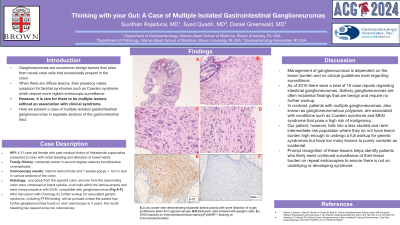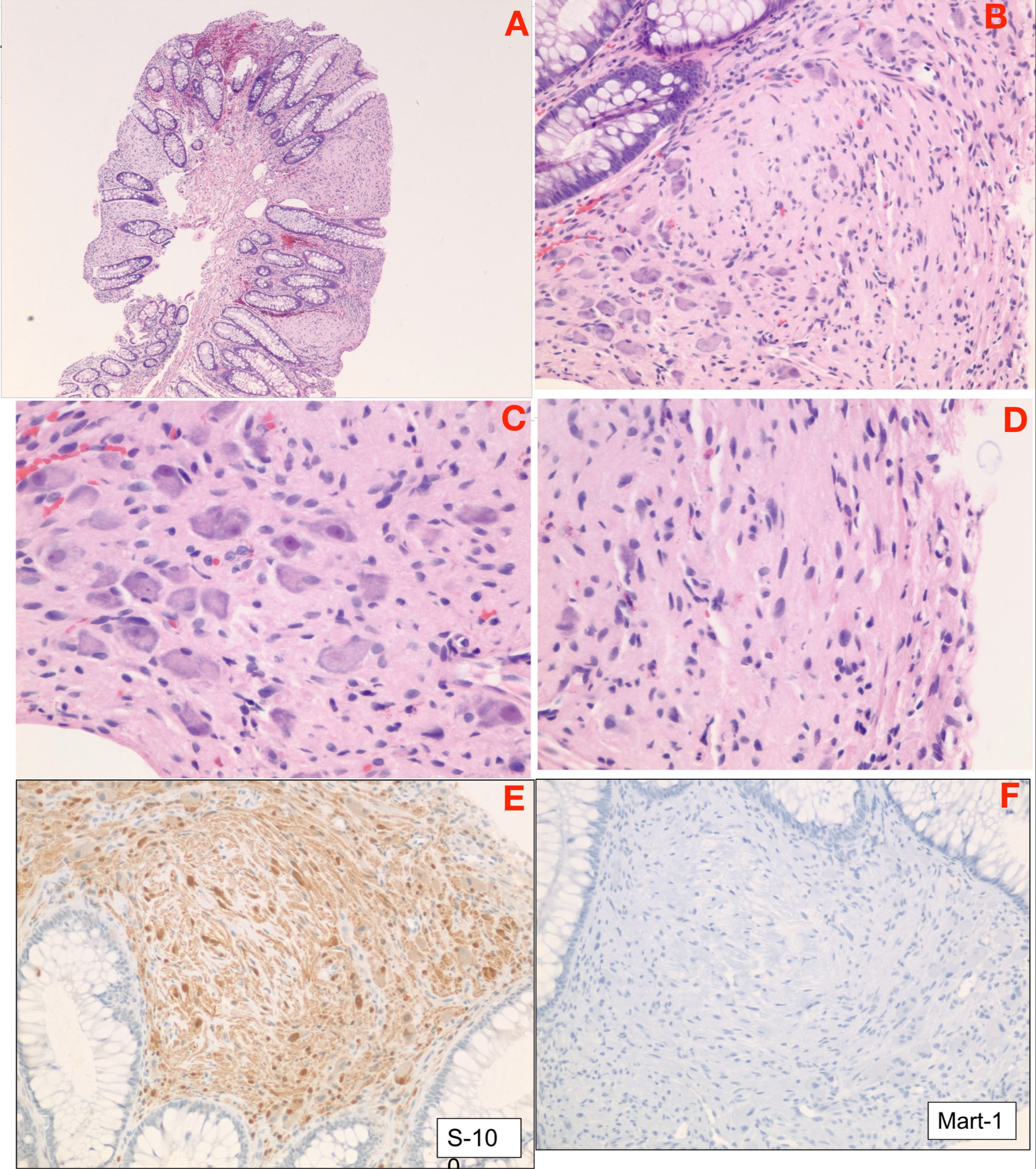Tuesday Poster Session
Category: Colon
P3720 - Thinking With Your Gut: A Case of Multiple Isolated Gastrointestinal Ganglioneuromas
Tuesday, October 29, 2024
10:30 AM - 4:00 PM ET
Location: Exhibit Hall E

Has Audio

Suvithan Rajadurai, MD
Brown Medicine/Lifespan
Providence, RI
Presenting Author(s)
Suvithan Rajadurai, MD1, Syed Quadri, MD1, Daniel Greenwald, MD2
1Brown Medicine/Lifespan, Providence, RI; 2Gastroenterology Associates, Providence, RI
Introduction: Ganglioneuromas are uncommon benign tumors that arise from neural crest cells that occasionally present in the gastrointestinal tract. When there are diffuse lesions, their presence raises suspicion for familial syndromes such as Cowden syndrome which require more vigilant endoscopic surveillance. However, it is rare for there to be multiple lesions without an association with clinical syndrome. Here we present a case of multiple isolated gastrointestinal ganglioneuromas in separate sections of the gastrointestinal tract.
Case Description/Methods: A 31-year-old female with past medical history of hidradenitis suppurativa presented to clinic with rectal bleeding and alteration of bowel habits. Her family history was notable for colorectal cancer in second degree relatives but otherwise unremarkable. Due to her hematochezia a colonoscopy was performed which demonstrated internal hemorrhoids as well approximately 7 sessile polyps < 1cm in size in several sections of the gastrointestinal tract. Histology revealed that one polyp from the sigmoid colon and one from the descending colon were composed of bland spindle- vivid cells within the lamina propria and were immunoreactive with S100, compatible with ganglioneuromas. After discussion with Oncology no further workup for associated genetic syndrome, including PTEN testing, will be pursued unless the patient has further ganglioneuromas found on next colonoscopy in 3 years. Her rectal bleeding has since ceased since her colonoscopy.
Discussion: Management of ganglioneuromas is dependent on the lesion burden and no clinical guidelines exist regarding surveillance. As of 2015 there were a total of 15 case reports regarding intestinal ganglioneuromas. Solitary ganglioneuromas are often incidental findings that are benign and require no further workup. In contrast, patients with multiple diffuse ganglioneuromas, also known as ganglioneuromatous polyposis, are associated with conditions such as Cowden syndrome and MEN syndrome that pose a high risk of malignancy. Our patient, however, falls into a less studied and rarer intermediate risk population where they do not have lesion burden high enough to undergo a full workup for genetic syndromes but have too many lesions to purely consider as incidental. Prompt recognition of these lesions helps identify these patients who likely need continued monitoring of their lesion burden on repeat
endoscopies to ensure there is not an underlying or developing syndrome.

Disclosures:
Suvithan Rajadurai, MD1, Syed Quadri, MD1, Daniel Greenwald, MD2. P3720 - Thinking With Your Gut: A Case of Multiple Isolated Gastrointestinal Ganglioneuromas, ACG 2024 Annual Scientific Meeting Abstracts. Philadelphia, PA: American College of Gastroenterology.
1Brown Medicine/Lifespan, Providence, RI; 2Gastroenterology Associates, Providence, RI
Introduction: Ganglioneuromas are uncommon benign tumors that arise from neural crest cells that occasionally present in the gastrointestinal tract. When there are diffuse lesions, their presence raises suspicion for familial syndromes such as Cowden syndrome which require more vigilant endoscopic surveillance. However, it is rare for there to be multiple lesions without an association with clinical syndrome. Here we present a case of multiple isolated gastrointestinal ganglioneuromas in separate sections of the gastrointestinal tract.
Case Description/Methods: A 31-year-old female with past medical history of hidradenitis suppurativa presented to clinic with rectal bleeding and alteration of bowel habits. Her family history was notable for colorectal cancer in second degree relatives but otherwise unremarkable. Due to her hematochezia a colonoscopy was performed which demonstrated internal hemorrhoids as well approximately 7 sessile polyps < 1cm in size in several sections of the gastrointestinal tract. Histology revealed that one polyp from the sigmoid colon and one from the descending colon were composed of bland spindle- vivid cells within the lamina propria and were immunoreactive with S100, compatible with ganglioneuromas. After discussion with Oncology no further workup for associated genetic syndrome, including PTEN testing, will be pursued unless the patient has further ganglioneuromas found on next colonoscopy in 3 years. Her rectal bleeding has since ceased since her colonoscopy.
Discussion: Management of ganglioneuromas is dependent on the lesion burden and no clinical guidelines exist regarding surveillance. As of 2015 there were a total of 15 case reports regarding intestinal ganglioneuromas. Solitary ganglioneuromas are often incidental findings that are benign and require no further workup. In contrast, patients with multiple diffuse ganglioneuromas, also known as ganglioneuromatous polyposis, are associated with conditions such as Cowden syndrome and MEN syndrome that pose a high risk of malignancy. Our patient, however, falls into a less studied and rarer intermediate risk population where they do not have lesion burden high enough to undergo a full workup for genetic syndromes but have too many lesions to purely consider as incidental. Prompt recognition of these lesions helps identify these patients who likely need continued monitoring of their lesion burden on repeat
endoscopies to ensure there is not an underlying or developing syndrome.

Figure: A.) Low- power view demonstrating expanded lamina propria with some distortion of crypts architecture taken from sigmoid sample. B-D.)Schwann cells admixed with ganglion cells. E.) S100 reactivity on immunohistochemical staining F.) MART-1 staining on immunohistochemistry
Disclosures:
Suvithan Rajadurai indicated no relevant financial relationships.
Syed Quadri indicated no relevant financial relationships.
Daniel Greenwald indicated no relevant financial relationships.
Suvithan Rajadurai, MD1, Syed Quadri, MD1, Daniel Greenwald, MD2. P3720 - Thinking With Your Gut: A Case of Multiple Isolated Gastrointestinal Ganglioneuromas, ACG 2024 Annual Scientific Meeting Abstracts. Philadelphia, PA: American College of Gastroenterology.
